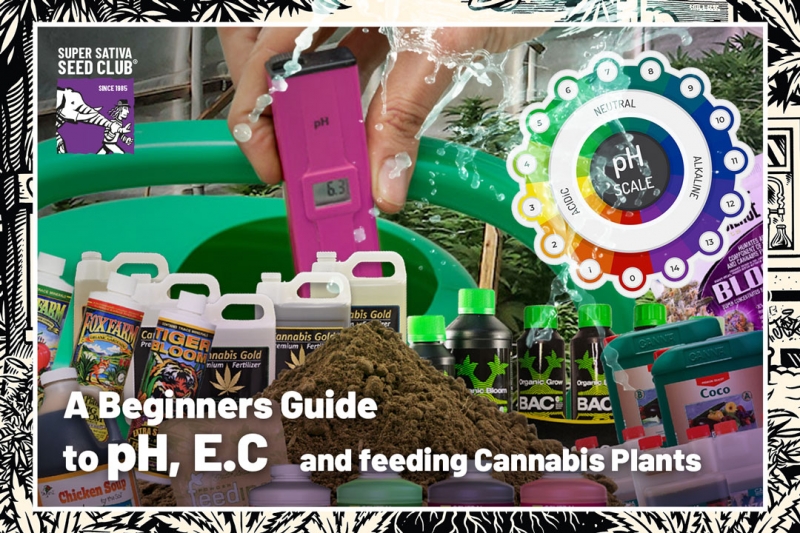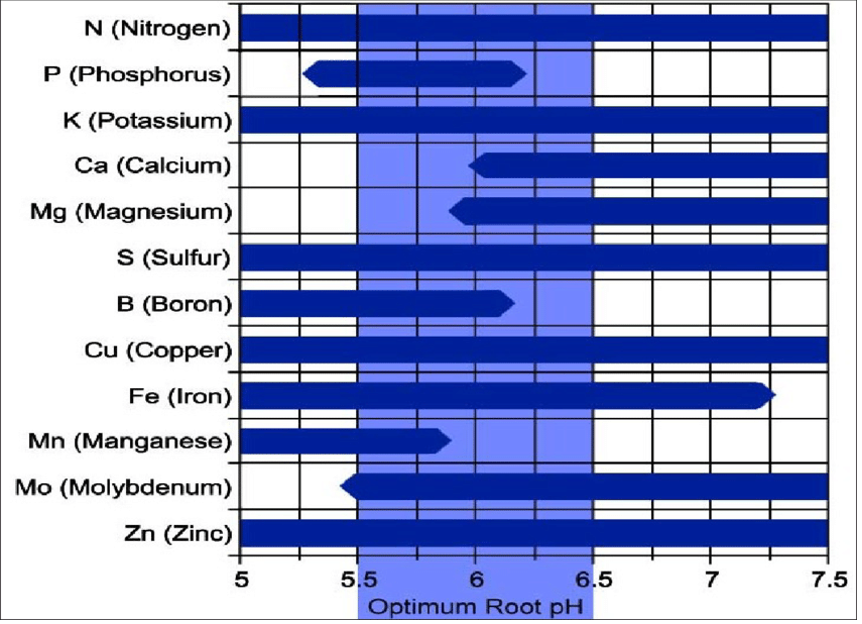
Feeding Cannabis plants nutrients from the day the seeds sprout, to the final flushing stage, is one way to ensure productive plants, capable of big yields. Understanding the pH level and electric conductivity of your water and nutrient solution can allow a grower to properly feed their plants, ensuring optimal nutrient uptake and utilization. In this article we explain all you need to know about pH, electric conductivity and why it is important when growing Cannabis plants.
What does pH mean, and why is it important when growing Cannabis?
The last time you may have had to work out the pH of a liquid solution was most likely in science class in high school. Potential hydrogen (pH) refers to how acidic or alkaline your water source may be, or once you have added liquid nutrients. From a scale of 1-14, neutral is represented by the number 7, however when it comes to growing Cannabis, we are required to keep the pH consistently between 5.0-6.0 for hydroponics, and 5.5-7.0 for organic crops.
The plants will use the nutrients as and when they need them. As seen in the chart below, primary nutrients and trace elements are all readily available at the different optimum root pH zone. How intense your indoor grow lights are, and the amount of carbon dioxide present, can also influence how much your plants drink.

What does E.C mean?
Electric conductivity goes hand in hand once you have calculated your pH levels. E.C refers to the amount of salt in a liquid solution. A good example would be to take one teaspoon of salt and dissolve it in the water. Once testing the E.C of the salt water mixture, you would notice the liquid scores far higher, displaying a high level of electric conductivity, in comparison to plain water.
How strong your nutrient solution will be, in PPM, will determine the E.C level, with many growers increasing the E.C level over time, then reducing back down once the final 2-3 weeks approaches.
So how do I check what my pH or E.C level is?
The best way to check your pH and E.C level is to use a digital pen that has been specifically calibrated. Digital pH pens will set you back around 10–20 euros, whilst E.C pens can cost a little more, with some models such as the truncation stick design costing over 100 euros.
You will want to check the pH levels of your nutrient solution after it has been made. Otherwise, the need to add more pH up or down is required for a second time. Some nutrients will cause pH levels to drift one way or another, however it is essential to have a digital reading after mixing every nutrient solution and second guessing is not advised.
How can I adjust my pH levels after mixing nutrients?
The same way you would do when adjusting the pH of a swimming pool, you just need to add either acid or alkaline in the liquid bottle form. Using a dropper and working drop by drop, you will simply stir in the pH up or down until your pH pen shows your optimal range, depending on your method of growing Cannabis.
● Always use a dropper and add one drop per time when using pH up or down.
● It is advised to wear gloves when using pH up or down to protect your skin.
● Be very careful not to allow the pH up or down to get in your eyes.
● You can still get access to the old school strip test kits if you cannot buy a digital pen.
The importance of water temperature when feeding Cannabis plants
When it comes to watering your plants, the ideal temperature of the water or nutrient solution is 18-22 degrees Celsius. Generally, warm water is fine, however you do not want to let the water become too cold and drop below 16 degrees Celsius or above 24 degrees Celsius if you can help it.
Nutrient solution which is too cold can shock the plants and cause the temperature of the growing medium and roots to dip to uncomfortable levels. Plants can enter a state of shock and in some cases slow down growth or flower production.
3 Top tips to consider when mixing nutrients
Mixing your nutrients may seem straightforward, but in the event of meeting certain parameters regarding pH and electric conductivity, below are a few top tips to consider the next time you are mixing nutrients.
Top tip #1 - It is a good idea to feed seedlings and young plants at a low E.C level. As plant’s mature and are able to handle large amounts of nutrients, our top tip is to generally increase the E.C level. You will want to be careful not to over feed the plants, causing nutrient burn.
Top tip #2 - The final two weeks of the feeding schedule should be the flushing stage. The reason why flushing Cannabis plants in an essential process, is to allow the internal nutrient reserves to be used up. Our top tip here is to feed only plain water, or an enzyme solution.
Top tip #3 - Vapor pressure deficit (VPD) is a way to calculate the amount of nutrients to feed the plants based on temperature and humidity. Our top tip here is to take a look into VPD, as it can be quite tricky, however will allow you to know exactly how much your plants are transpiring water.
Our Conclusion
When it comes to growing Cannabis using organic substrates and liquid nutrients, a beginner grower will not need to be so concerned with E.C levels, however, hydroponic systems require a much more disciplined approach. Making sure you have the correct balance between pH and electric conductivity is one way to grow the best plants, but make sure you give your crop a thorough flushing for the best taste and experience.
(1667) (0)

